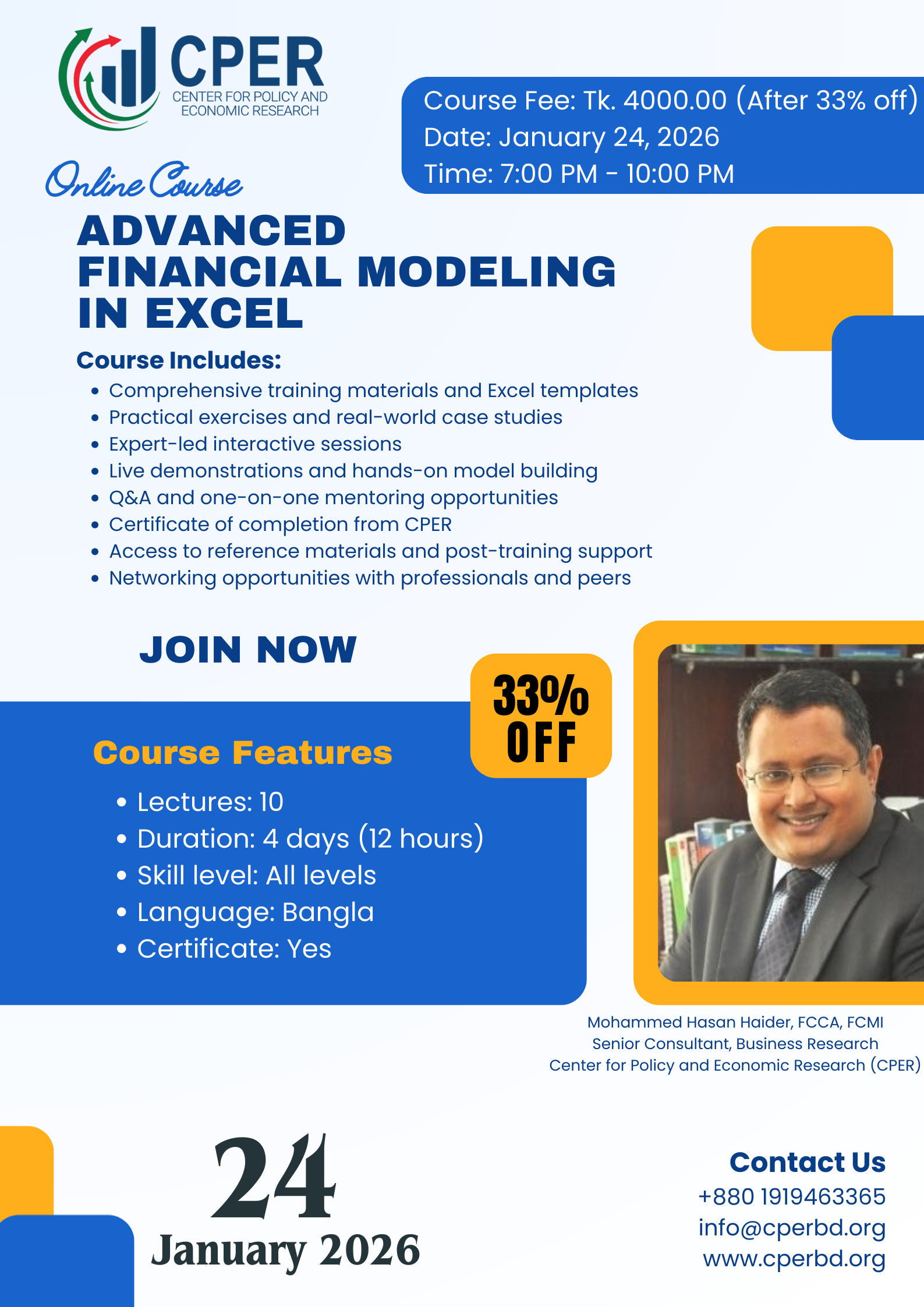Course Instructor: Mohammed Hasan Haider, FCCA, FCMI
Profile of Course Instructor: https://cperbd.org/profile/17
Course Overview:
The "Advanced Financial Modeling in Excel" course aims to equip participants with the skills required to build robust financial models using Excel. This training will cover the essential aspects of financial modeling, including constructing income statements, cash flow analysis, forecasting balance sheets, and performing advanced valuation techniques such as Discounted Cash Flow (DCF) and Weighted Average Cost of Capital (WACC). The course will also emphasize real-world financial concepts, tax computations, and sensitivity analysis, enabling participants to develop comprehensive, adaptable models.
Course Objective:
By the end of this training, participants will be able to:
- - Build accurate financial models using Excel for decision-making and analysis.
- - Understand and apply key concepts like cash flow management, depreciation, tax computations, and balance sheet forecasting.
- - Develop skills in using advanced techniques such as DCF valuation, WACC, and sensitivity analysis.
- - Perform quality control checks to ensure the reliability and accuracy of their financial models.
Why This Course is Essential:
In today’s fast-paced business environment, financial modeling has become a vital tool for professionals across industries. Whether you are working in finance, consulting, project management, or business development, the ability to build and interpret financial models is crucial for making informed decisions. This course offers hands-on Excel training, equipping participants with practical skills to assess financial health, project future cash flows, and evaluate business performance.
Benefits of this Training/Course:
- - Practical Skills: Learn step-by-step how to construct financial models using Excel.
- - Improved Decision-Making: Gain insights into cash flows, profitability, and valuation methods to make informed business decisions.
- - Valuable Tools for Professionals: Master advanced Excel techniques used in real-world financial modeling and forecasting.
- - Industry-Relevant Knowledge: Understand key financial concepts, including tax calculations, asset management, and sensitivity analysis.
- - Hands-On Experience: Work on real-life case studies and examples to reinforce learning.
Course Includes:
- - Comprehensive training materials and Excel templates
- - Practical exercises and real-world case studies
- - Expert-led interactive sessions
- - Live demonstrations and hands-on model building
- - Q&A and one-on-one mentoring opportunities
- - Certificate of completion from CPER
- - Access to reference materials and post-training support
- -Networking opportunities with professionals and peers
Course Outline:
Day 1
Session 1: Income Statement
- - Understanding the first step in building any financial model.
- - Key components of an income statement.
- - Proper order of items for clarity and accuracy in the model.
Session 2: Introducing a Cash Calculation
- - Importance of cash flows and distinguishing them from accounting profits.
- - How to calculate cash flows accurately in Excel?
- - Handling interest calculations without circular references.
- - Time-weighted average cash calculations.
- - Types of debt used by companies and their implications on cash flow.
Session 3: Fixed Assets
- - What are fixed assets, and why is depreciation used?
- - Calculating depreciation using straight-line and reducing balance methods.
- - Approaches for creating fixed asset models with limited data.
- - Methods for calculating alternative fixed asset figures when more data is available.
Day 2
Session 4: Balance Sheet
- - How to build a forecasted balance sheet in Excel?
- - Utilizing backing schedules to forecast receivables, payables, and inventory.
- - Using ratios to forecast financial elements and avoid errors in the model.
Session 5: Tax Computations
- - Difference between accounting and taxable profits.
- - Steps for adjusting from accounting to taxable profits.
- - Capital allowances and how to handle tax losses.
- - Deferred tax computations and provisions.
Session 6: Shareholdings, Dividends, and Goodwill
- - Overview of different types of shares and their implications for dividends.
- - Calculation of dividends for preference and ordinary shareholders.
- - Understanding how goodwill arises and how it is treated in various tax jurisdictions.
Day 3
Session 7: Sensitivity Analysis
- - What is sensitivity analysis, and how to apply it to financial models.
- - Importance of model structure before applying sensitivity analysis.
- - Incorporating inflation factors and handling changes in model assumptions.
- - Best practices for updating input references in Excel.
Session 8: Discounted Cash Flow (DCF) Valuation
- - Theory behind DCF valuation and its significance.
- - Key challenges and assumptions in DCF models.
- - How to calculate a company’s valuation using DCF in Excel.
- - Incorporating multiple tools for a more accurate valuation.
Day 4
Session 9: Weighted Average Cost of Capital (WACC)
- - Understanding the components of WACC: cost of debt, equity, and preference shares.
- - How to calculate WACC using market values.
- - Application of WACC in acquisition models and forecasting.
Session 10: Quality Control
- - Critical importance of quality control in financial modeling.
- - Methodologies for running quality control tests on models.
- - How to present and verify sector-specific models for accuracy.

